‘A life blighted by rancid men’: how Hollywood failed Rita Hayworth
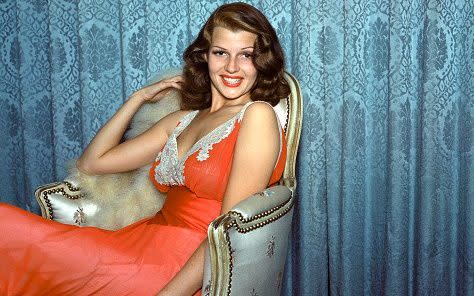
In the Stephen King novella Rita Hayworth and the Shawshank Redemption, wrongly imprisoned lifer Andy Dufresne spends 25 years staring at a picture of the Hollywood star on the wall of his cell. The photograph hides a hole he's been patiently chiseling in the concrete, his only means of escape; he imagines stepping into the picture and leaving this hell behind.
Both in the book and its 1994 film adaptation, for Andy the pin-up comes to symbolise freedom and a sense of hope. Yet in real life, Hayworth - the epitome of post-war glamour - had little of either. Controlled by an abusive father from an early age, then mistreated by a succession of studio heads and husbands, wealth and fame soon came her way. But so did five disastrous marriages, alcoholism and a dismal end of life when she was “utterly helpless” and ravaged by Alzheimer’s disease.
Even as each week brings us a new Hollywood sob story - most recently, Bill and Ted star Alex Winter detailed the abuse he endured as a child star - Hayworth's will always be one of the saddest ever told.
Hayworth was born Margarita Carmen Dolores Cansino in New York on October 17 1918. She had no real childhood – it was more like a brutal training regime. “I didn't like dancing very much, but I didn't have the courage to tell my father. Rehearse, rehearse, rehearse. That was my girlhood,” the actress, who went on to make 61 films over 37 years, recalled of her life with her Spanish-born flamenco dancer father Eduardo Cansino.
At 12 she was taken out of school by Eduardo to be his full-time partner in The Dancing Cansinos. She was dressed in skimpy clothes and told to wear scarlet lipstick. To evade American child labour laws, the pair worked on gambling boats off the California coast and in sleazy casinos and nightclubs in Tijuana, Mexico. He would introduce his child as his wife. Mistakes on stage resulted in severe beatings.

It was not until decades later, when Barbara Leaming, author of If This Was Happiness: A biography of Rita Hayworth, interviewed the star’s third husband, film titan Orson Welles, that the full horrific truth about her ordeal in the 1930s came to light. “Orson told me about her rages and personality changes. One day I asked him about incest. That incredible voice broke. And he said, ‘yes, it was true’,” Leaming wrote, adding, “Eduardo raped her in the afternoons and danced with her at night.”
In 1935, after occasional bit-part work as a ‘Latin extra’ in movies shot in Mexico, the 16-year-old was spotted dancing in a club in Agua Caliente by a producer for Fox. He signed her to a contract and she made her cinema debut in Under the Pampas Moon. The same year, still billed as Rita Cansino, she starred in Charlie Chan in Egypt and danced with Spencer Tracy in Dante’s Inferno. For the next couple of years, she picked up a dozen small roles in B-movies.
In this period she came into contact with a chancer called Edward Charles Judson, who wooed the teenage starlet by pretending to be a wealthy Texas oilman (he was a car salesman) and persuading her to hire him as her manager. They wed in May 1937.
“Basically, I am a good, gentle person, but I am attracted to mean personalities,” Hayworth admitted to People magazine in 1974. Judson was worse than mean. The 41-year-old, who had three divorces behind him, admitted that the 18-year-old actress was his “investment”. He pressurised her into dying her hair from black to auburn, altering her eyebrows and raising her hairline through a painful electrolysis process. He physically abused her if she resisted his demands.
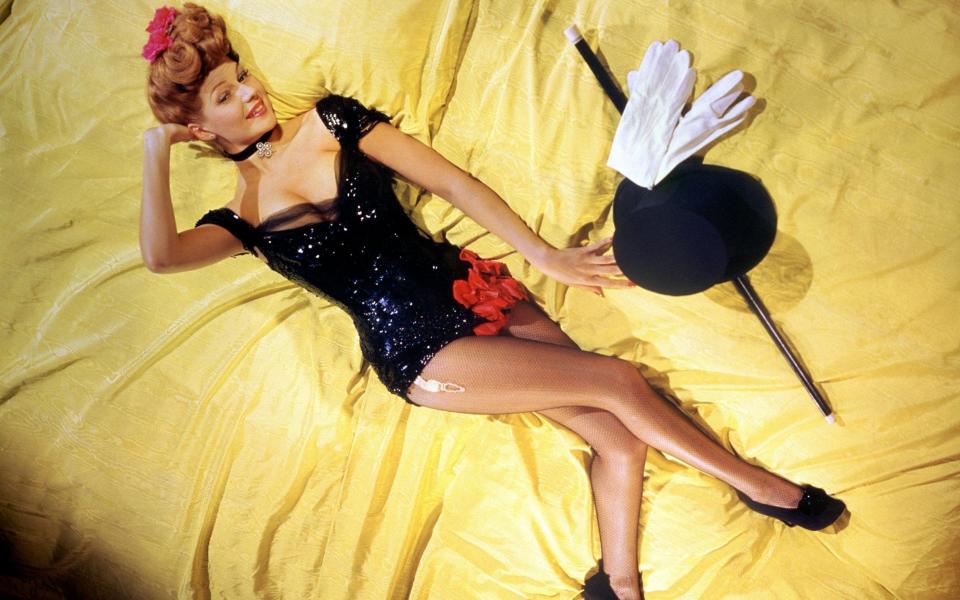
Judson hired press agents to get her photograph into newspapers – they used fabricated film award certificates – and he assiduously courted Harry Cohn, even offering to let the head of Columbia Pictures sleep with his teenage wife. Hollywood agent Budd Burton Moss told Larry King “people thought he was a pimp”. She signed to Columbia, who billed her as Rita Hayworth. The name, which tipped a nod to her mother Volga Haworth, a former Ziegfeld Follies showgirl, was Judson’s idea.
The switch to Columbia brought stronger parts, including a notable role alongside Cary Grant in 1939’s Only Angels Have Wings, but it was not until 1941 that she felt independent enough to quit her marriage. She had established herself with successful performances in The Strawberry Blonde, Blood and Sand, starred with Fred Astaire in You'll Never Get Rich, and been on the cover of Time magazine.
Judson threatened to throw hydroxide in her face and vowed to inflict “great bodily harm” if she tried to leave him. He only agreed to a divorce after she signed over lucrative California real estate and gave him $12,000 in cash. “He helped me with my career and helped himself to my money,” she said after the divorce was sealed in February 1942.

Hayworth was suddenly America’s most famous single woman. Life magazine writer Winthrop Sargent dubbed her “The Great American Love Goddess”, and the description stuck. Bob Landry’s famous cover photograph – showing the actress on a bed dressed in a dark satin and lace nightgown – became world famous.
It is the image on the poster that Andy Dufresne puts up in his cell in The Shawshank Redemption. The glamour of being a pin-up icon masked the truth about a woman riddled with insecurities. “I naturally am very shy and I suffer from an inferiority complex,” she admitted to Life.
Her first film after the split from Judson was a successful reunion with Fred Astaire in You Were Never Lovelier. She enjoyed working with the master dancer and even laughed about the time when she was dancing with Astaire and slipped on a Formica floor, knocking herself out.

After a brief, tempestuous affair with billionaire Howard Hughes fizzled out, Hayworth was courted by filmmaker Welles (who was besotted by that Life photograph) and they wed in September 1943. Their daughter, Rebecca, was born a year later.
Hayworth won praise for her performance in Cover Girl with Gene Kelly in 1944, but her defining career appearance came two years later, when she was cast opposite Glenn Ford as Gilda Mundson Farrell. “When she made Gilda the whole world fell in love with her,” said Burton Moss.
The film included a suggestive song called Put the Blame on Mame (Anita Ellis dubbed for Hayworth’s singing) during a scene in which Hayworth, dressed in a clinging black satin strapless gown, slowly and seductively removed arm-length gloves. The controversial strip scene was a national talking point.
In July 1946, a month after Gilda’s release, a portrait of Hayworth was glued on to the side of the Able atomic bomb when it was dropped on Bikini Atoll. It was the first atomic device tested in peace time. “Rita used to fly into terrible rages all the time, but the angriest was when she found out that they’d put her on the atom bomb,” Welles said. “Rita almost went insane she was so angry. She wanted to go to Washington to hold a press conference, but Cohn wouldn’t let her, because it would be unpatriotic.”
Her marriage to Welles was imploding. She was frustrated about his controlling behaviour, which included writing out lists of books he thought necessary to improve her mind, and despite working together on The Lady from Shanghai, they finally divorced in November 1947. Both had regularly broken their fidelity vows.
Hayworth’s on-screen chemistry with Ford in Gilda had ignited a passionate real-life affair. Peter Ford confirmed in his 2011 biography Glenn Ford: A Life that his father got Hayworth pregnant during the filming of 1948’s The Loves of Carmen, prompting Hayworth to fly to France for an abortion.

By that stage, Hayworth was one of Hollywood’s highest-paid actresses – earning more than £5 million a year in today’s money – with a lucrative contract to model Max Factor lipsticks. Despite her wealth, Hayworth was frustrated by being trapped in a Hollywood “star system”, typecast as a siren.
“Gilda became a hindrance because I was made as a certain kind of image,” she told a television interviewer in 1967. “I didn’t want to be Gilda all my life and felt I could do many other parts and wanted to change my pace. I started to break away from Columbia Pictures.”
Another trigger for her row with the studio was her affair with wealthy playboy Prince Aly Khan, son of Aga Khan III, a liaison that prompted a boycott of her films led by the General Federation of Women’s Clubs, who objected to her romance with a prominent married Muslim. “I was really in deep slavery,” Hayworth complained, claiming that Columbia boss Cohn bugged her dressing room. In 1948, after a trip to Europe with Khan, she was suspended and sued for breach of contract (inspiring the clever Hollywood Reporter headline, ‘From Cohn to Cannes to Khan to Canned’).

Hayworth, then 29 and two months pregnant, married 38-year-old Khan in May 1949, at his Riviera mansion. With the seal of a 32-carat diamond ring, she married into royalty. Their daughter, Princess Yasmin, was born seven months later in Switzerland. This was a tough period for Hayworth. She gave up acting for four years and was sent into a spin almost immediately by rumours that her womanising husband was sleeping around.
After a protracted divorce battle – in which she cited “extreme cruelty, entirely mental in nature” – she left Khan in 1951, after he agreed that she retained custody of Yasmin and raised her as a Christian.
Although Hayworth was not without self-awareness – “every man I knew had fallen in love with Gilda and wakened with me,” she stated – she was incapable of learning from her mistakes. In September 1953, she bounced straight into a marriage with big band singer Dick Haymes, a scheming alcoholic known throughout Hollywood as ‘Mr Evil’. “She became wildly self-destructive after she divorced Aly,” wrote Leaming. “Her marriage to Haymes was kind of like a public nervous breakdown.”
Haymes, twice married previously and facing legal action over unpaid child support, was another Ludser-like lowlife. He regularly physically assaulted Hayworth and burned through her money. The final straw came when he punched her in the face at the Cocoanut Grove nightclub in Los Angeles. She fled to New York and initiated another round of divorce proceedings.
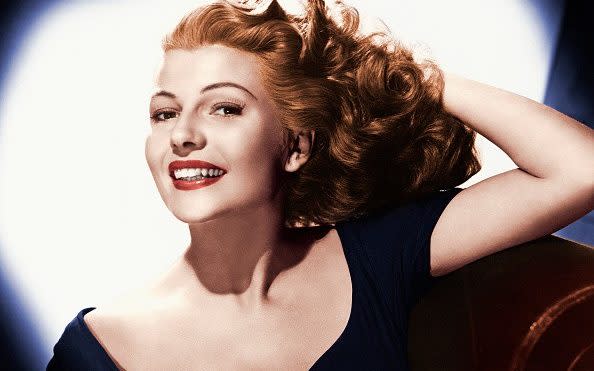
Life was strange and difficult for Hayworth’s children. The actress was investigated by The Society for the Prevention of Cruelty to Children in April 1954 when she left nine-year-old Rebecca and her half-sister Yasmin with a nanny in New York, while she travelled to Florida for an extended holiday with Haymes. Neighbours complained that the children had been left to play in the garbage in the street. Although Hayworth was not charged with neglect, the children were placed under court supervision for three months.
She pulled herself together after leaving Haymes and enjoyed some happy family moments. When she was in England in 1956 to promote her film Fire Down Below with Jack Lemmon she talked about the joy of a visit to the Tower of London where she had bought her daughters “stacks and stacks of souvenirs”
These moments were few and far between, though. Being the daughter of Hayworth and Orson Welles was particularly hard for Rebecca, who was packed off to summer camps and boarding schools all around Europe as a teenager. “Sometimes I am real bitter about it, about what being a child of celebrities has done to me,” the 27-year-old told Roto magazine in 1972. “Mother and Father have never been to my home in Tacoma. Not even when my husband Perry Moede and I were married. As far as they are concerned, I’m on my own,” added Rebecca, who died in 2004 at the age of 59.
Hayworth had been drinking heavily since the 1950s. Robert Schiffer, who worked regularly as her makeup artist, said the actress sometimes drank to overcome nerves, but also sought refuge in alcohol from her torments. “She had a lot of problems in her life, with her father especially, that weighed heavily on some of her depressions, when she would have a drink or two or three or four,” he said.
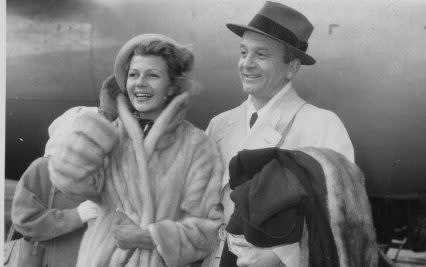
In late 1957, she began romancing film producer James Hill – who was a partner in Burt Lancaster’s film company – and they wed in February 1958. Professionally, the marriage had its benefits (he put her in the excellent film Separate Tables and encouraged her to star in the acclaimed They Came to Cordura) but it was another appalling choice for her personal life.
Actor Charlton Heston and his wife Lydia dined with the newlyweds in Spain and in his autobiography he described the meal as “the single most embarrassing evening of my life”. Heston said Hill heaped “obscene abuse” on Hayworth until she was “reduced to a helpless flood of tears, her face buried in her hands”. Heston said he wished he had “slugged” Hill and recalled that he and his wife left mid-meal. “I'm ashamed of walking away from Miss Hayworth’s humiliation. I never saw her again,” he added.
Hill’s temper tantrums were explosive and the couple had vicious fights, including one in which Hayworth hurled a candelabra at Hill’s head. They divorced in 1961 and, strange as it seems, remained good friends thereafter. In 1983, Hill wrote the book Rita Hayworth: A Memoir, which included an odd reminiscence about his first meeting with Hayworth, in Mexico when they were teenagers, when he “thought her a prostitute”.
Hayworth’s main solace at this time was her relationship with Yasmin, who remembered her mother’s passion for oil painting, golf, playing tennis and playing the castanets in their Beverley Hills mansion. “I had a wonderful childhood,” Khan told Fox News. “I was in awe of her. I remember the excitement of Circus World with John Wayne. I just remember her as a loving, loving mother.”
Circus World was released in 1964 and earned Hayworth a Golden Globe nomination for Best Actress in a Motion Picture Drama. As the 1960s wore on, film roles dried up and her mental state declined. She felt cast aside by the industry, telling one reporter, “I’m an actress. I have depth. I have feeling. But they don’t care. All they want is an image.”
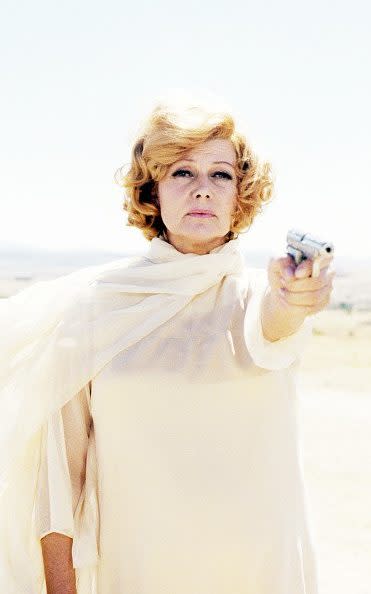
At the end of the decade, after a few desultory television appearances, she held discussions about taking on a Broadway role, but talks ended abruptly when it was clear that she was unable to remember her lines. Her final movie role came in 1972, alongside Robert Mitchum, when she played gun-slinging OAP Senora de la Plata in a light-hearted western called The Wrath of God. When Roger Ebert reviewed the film, he did not even mention Hayworth.
In January 1976, she was in the news again for an incident at Heathrow airport. Alongside photographs of the actress being helped from a plane, were reports of Hayworth “looking dishevelled, distressed and waving her arms in protest”. The tabloid reports quoted a stewardess saying that Hayworth “had too much to drink and made a nuisance of herself”.
Days later, she still seemed confused during an appearance on Russell Harty’s chat show. Soon afterwards, on the recommendation of a physician who said Hayworth was disabled by chronic alcoholism, a court in Santa Ana, California, put an administrator in charge of her affairs.
What was not apparent at the time – something that did not become clear until a formal diagnosis in 1980 – was that she was suffering from advanced Alzheimer’s. Yasmin became her legal guardian and cared for Hayworth in their Manhattan apartment.
“She would get angry and belligerent for no reason. I had to regulate her medication as she became more aggressive. It was very painful,” her daughter admitted. Hayworth was 68 when she died on 14 May 1987, just three days after the second annual Rita Hayworth Gala, hosted by Yasmin, had raised $1.3 million for the Alzheimer’s Society.
“I’ve had a lot of unhappiness in my life – who doesn’t?” Hayworth lamented. Despite all her success, it’s hard not to pity the anguish of a life blighted by rancid men. Those closest to her were pained by her tragic life. “Rita was such a lonesome, sad girl away from the screen,” said Burton Moss.
In Hill’s book about his former wife, there is a moving account of the time when the young Margarita Cansino, lured by the sounds of a carousel, slipped away from her father’s practice routine at the New Jersey amusement pier to have fun. She told Hill about the wonderful peace she found just sitting on the horse by herself.
“Ever since then if I don’t like where I am, or who I’m with, or myself – if I don’t like me, which happens the most often – that carousel comes to mind, and once I hear the music, I am back on that horse,” Hayworth said. “It always makes me sad, because somehow, someone or something will be along, and I’ll have to leave.”

